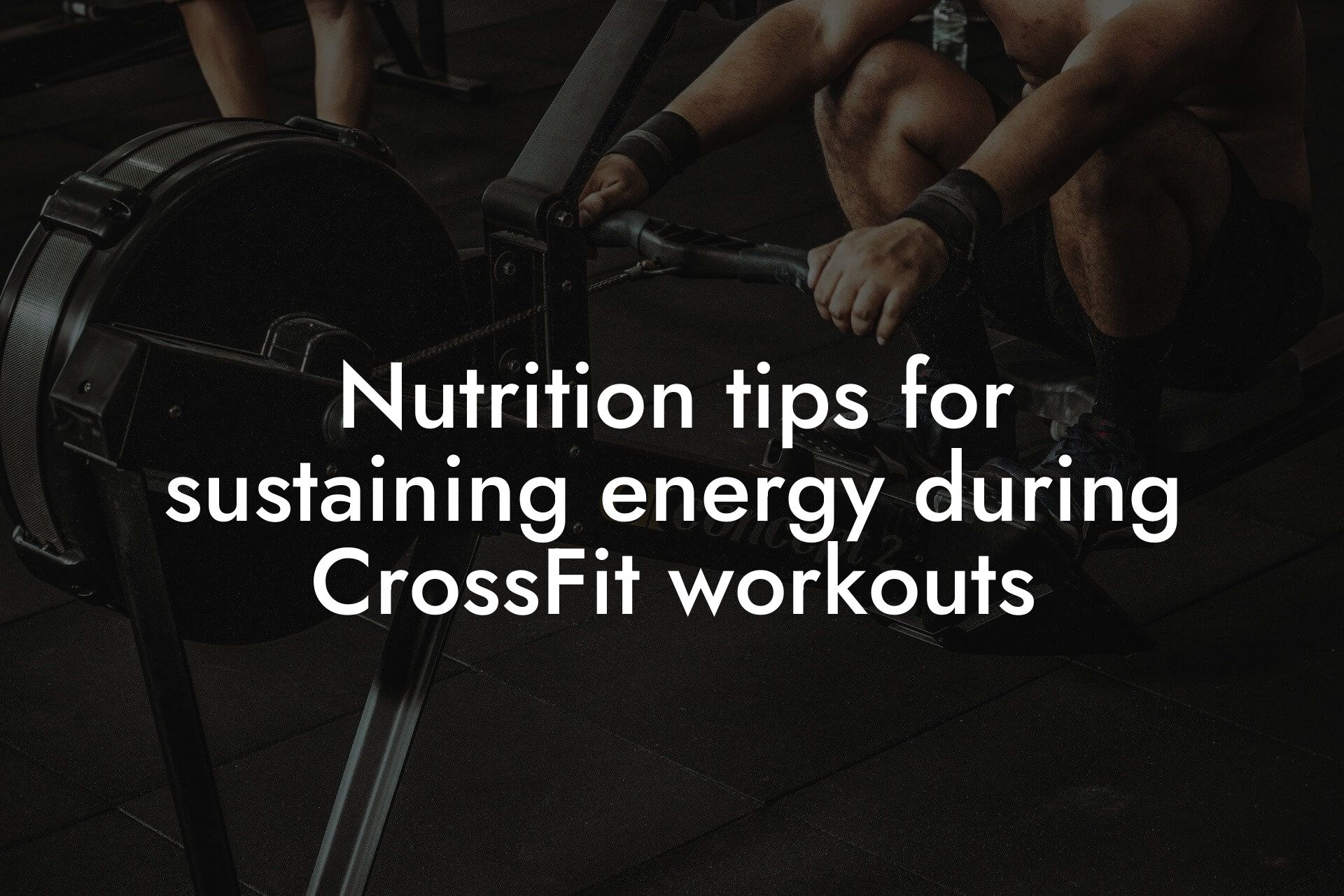As a high-earning professional, you understand the importance of maintaining a strong, lean, and agile physique. CrossFit, a high-intensity fitness program, can help you achieve your physical goals, but it requires a delicate balance of strength, speed, and flexibility. In this article, we'll delve into the world of CrossFit and provide you with a comprehensive guide on how to balance these three essential components to take your fitness journey to the next level.
Table of Contents
- Understanding the Importance of Balance in CrossFit
- Assessing Your Current Fitness Level
- Building Strength in CrossFit
- Improving Speed and Agility in CrossFit
- Increasing Flexibility and Mobility in CrossFit
- Periodization and Programming for Balance
- Incorporating Active Recovery and Rest
- Monitoring Progress and Adjusting Your Program
- Frequently Asked Questions
Understanding the Importance of Balance in CrossFit
In CrossFit, athletes often focus on building strength, speed, and flexibility separately, but neglecting one aspect can lead to plateaus, injuries, or poor performance. A well-rounded CrossFit athlete needs to balance these three components to achieve optimal results. Strength provides the foundation for power and endurance, speed enhances agility and reaction time, and flexibility allows for efficient movement and injury prevention. By balancing these elements, you'll improve your overall performance, reduce the risk of injury, and enhance your physical appearance.
Assessing Your Current Fitness Level
Before diving into a CrossFit program, it's essential to assess your current fitness level. This includes evaluating your strength, speed, and flexibility. You can do this by:
- Conducting a strength test, such as a 1RM (one-rep max) squat or deadlift
- Timing yourself in a sprint or agility drill
- Performing a flexibility assessment, such as a sit-and-reach test or shoulder mobility evaluation
Having a clear understanding of your strengths and weaknesses will help you create a personalized training program that targets areas for improvement.
Building Strength in CrossFit
Strength is the foundation of CrossFit, and it's essential to develop a strong base to improve overall performance. Focus on exercises that work multiple muscle groups at once, such as:
- Squats, deadlifts, and Olympic lifts
- Upper body exercises like push-ups, pull-ups, and dips
- Core exercises like planks, side planks, and Russian twists
Incorporate strength training exercises into your routine 2-3 times a week, with a focus on progressive overload (increasing weight or reps over time) to continue making gains.
Improving Speed and Agility in CrossFit
Speed and agility are critical components of CrossFit, allowing you to move quickly and efficiently during workouts. Incorporate exercises that challenge your speed and agility, such as:
- Sprints, shuttle runs, and agility drills
- Plyometric exercises like box jumps and burpees
- Reaction training, such as reacting to a stimulus or changing direction quickly
Incorporate speed and agility training into your routine 1-2 times a week, focusing on short, intense intervals to improve your anaerobic endurance.
Increasing Flexibility and Mobility in CrossFit
Flexibility and mobility are often overlooked in CrossFit, but they're essential for injury prevention and optimal performance. Incorporate exercises that improve flexibility and mobility, such as:
- Static stretches, like hamstring and hip flexor stretches
- Dynamic stretches, like leg swings and arm circles
- Mobility exercises, like shoulder rotations and hip openers
Incorporate flexibility and mobility exercises into your routine 2-3 times a week, focusing on exercises that target areas of tightness or restricted range of motion.
Periodization and Programming for Balance
To achieve balance in CrossFit, it's essential to periodize your training and programming. This means varying your training focus every 4-6 weeks to avoid plateaus and ensure continued progress. A sample periodization plan might look like this:
- Weeks 1-4: Strength focus, with an emphasis on building strength in key lifts
- Weeks 5-8: Speed and agility focus, with an emphasis on improving speed and reaction time
- Weeks 9-12: Flexibility and mobility focus, with an emphasis on improving range of motion and reducing injury risk
By periodizing your training, you'll ensure that you're making progress in all areas and avoiding plateaus.
Incorporating Active Recovery and Rest
Active recovery and rest are crucial components of a balanced CrossFit program. Incorporate activities like yoga, stretching, or light cardio to aid in recovery and reduce muscle soreness. Aim for 1-2 rest days per week, where you avoid intense training and focus on recovery.
Monitoring Progress and Adjusting Your Program
Regularly monitoring your progress is essential to achieving balance in CrossFit. Use tools like a training log or mobile app to track your workouts, and adjust your program as needed. Pay attention to changes in your strength, speed, and flexibility, and make adjustments to your training focus accordingly.
At Tano Performance Group, we understand the importance of balancing strength, speed, and flexibility in CrossFit. Our comprehensive body assessment using a DEXA machine provides you with a detailed understanding of your body composition, bone density, and physique, allowing you to make informed decisions about your training program. By incorporating our expert guidance and cutting-edge technology, you'll be able to achieve a balanced and optimal physique, taking your business and personal life to the next level.
Remember, balancing strength, speed, and flexibility in CrossFit requires patience, dedication, and a willingness to adapt. By following the guidelines outlined in this article, you'll be well on your way to achieving a strong, lean, and agile physique that will serve you well in both your personal and professional life.
Frequently Asked Questions
What is CrossFit and how does it relate to balancing strength, speed, and flexibility?
CrossFit is a high-intensity fitness program that combines various exercises and movements to improve overall physical fitness. Balancing strength, speed, and flexibility is crucial in CrossFit as it enables individuals to perform exercises efficiently and effectively, reducing the risk of injury and improving overall performance.
Why is strength important in CrossFit?
Strength is essential in CrossFit as it provides the foundation for performing exercises and movements. Having adequate strength enables individuals to lift heavier weights, generate more power, and sustain intense efforts over time. Stronger muscles also provide better joint stability and support, reducing the risk of injury.
How can I improve my strength in CrossFit?
To improve strength in CrossFit, focus on exercises that work multiple muscle groups at once, such as squats, deadlifts, and bench press. Incorporate progressive overload, where you gradually increase the weight or resistance over time, to continue challenging your muscles and promoting growth.
What is the importance of speed in CrossFit?
Speed is critical in CrossFit as it enables individuals to complete exercises and workouts quickly and efficiently. Faster times and higher intensities can lead to improved cardiovascular fitness, increased caloric expenditure, and enhanced athletic performance.
How can I improve my speed in CrossFit?
To improve speed in CrossFit, incorporate exercises that require quick movements and rapid contractions, such as sprints, box jumps, and burpees. Focus on explosive power training, where you generate maximum force in a short amount of time, to improve your ability to move quickly and efficiently.
Why is flexibility important in CrossFit?
Flexibility is essential in CrossFit as it enables individuals to move freely and efficiently, reducing the risk of injury and improving overall performance. Good flexibility also allows for better range of motion, making it easier to perform complex movements and exercises.
How can I improve my flexibility in CrossFit?
To improve flexibility in CrossFit, incorporate exercises that target specific joints and muscle groups, such as mobility drills, stretching, and foam rolling. Focus on maintaining proper form and technique, as poor form can lead to reduced flexibility and increased risk of injury.
What is the ideal balance between strength, speed, and flexibility in CrossFit?
The ideal balance between strength, speed, and flexibility in CrossFit varies depending on individual goals and needs. A general rule of thumb is to focus on building strength and flexibility simultaneously, while incorporating speed and power training to improve overall athleticism.
How can I assess my current balance of strength, speed, and flexibility?
Assess your current balance of strength, speed, and flexibility by tracking your performance in various exercises and workouts. Use metrics such as maximum lifts, workout times, and mobility scores to gauge your progress and identify areas for improvement.
What are some common mistakes people make when trying to balance strength, speed, and flexibility in CrossFit?
Common mistakes include focusing too much on one aspect and neglecting others, not incorporating proper warm-ups and cool-downs, and ignoring proper form and technique. Additionally, not listening to your body and pushing through pain or fatigue can lead to injury and imbalance.
How can I incorporate CrossFit into my busy schedule?
Incorporate CrossFit into your busy schedule by finding a gym or workout routine that fits your schedule, setting realistic goals and expectations, and prioritizing consistency over perfection. Even 2-3 times per week can be beneficial for improving overall fitness and balance.
What are some modifications I can make to CrossFit exercises to accommodate my fitness level?
Modify CrossFit exercises to accommodate your fitness level by reducing the weight, reps, or sets, or by substituting exercises with similar movements that are less intense. Additionally, focus on proper form and technique, and don't be afraid to ask for guidance or scaling options from a qualified coach.
How can I prevent injuries while balancing strength, speed, and flexibility in CrossFit?
Prevent injuries in CrossFit by warming up properly, cooling down thoroughly, and listening to your body. Focus on proper form and technique, and don't push through pain or fatigue. Additionally, incorporate injury prevention exercises and stretches, such as shoulder mobilization and ankle mobility drills.
What role does nutrition play in balancing strength, speed, and flexibility in CrossFit?
Nutrition plays a critical role in balancing strength, speed, and flexibility in CrossFit. Focus on consuming a balanced diet that includes adequate protein, complex carbohydrates, and healthy fats to support muscle growth and recovery.
How can I track my progress and stay motivated in CrossFit?
Track your progress and stay motivated in CrossFit by setting realistic goals and expectations, tracking your workouts and progress, and finding a supportive community or workout buddy. Celebrate small victories and don't be too hard on yourself – every step forward is progress.
What are some common myths about CrossFit and balancing strength, speed, and flexibility?
Common myths include the idea that CrossFit is only for elite athletes, that it's too intense or dangerous, or that it's only for young people. Additionally, some people believe that strength and flexibility are mutually exclusive, or that speed and power training are only for athletes.
How can I find a qualified CrossFit coach or gym?
Find a qualified CrossFit coach or gym by researching local gyms, reading reviews and testimonials, and observing classes or workouts. Look for coaches who are certified, experienced, and knowledgeable, and who prioritize proper form and technique.
What are some additional resources I can use to improve my balance of strength, speed, and flexibility in CrossFit?
Additional resources include online workout platforms, fitness apps, and educational websites. Utilize resources such as CrossFit.com, MobilityWOD, and gymnastics training to improve your skills and knowledge.
How can I incorporate CrossFit into my long-term fitness goals?
Incorporate CrossFit into your long-term fitness goals by setting realistic and achievable goals, creating a training plan, and tracking your progress. Focus on consistency and patience, and don't be afraid to adjust your goals and training plan as needed.
What are some common misconceptions about flexibility and mobility in CrossFit?
Common misconceptions include the idea that flexibility is only for gymnasts or yogis, that it's not important for strength or power, or that it's only for injury prevention. Additionally, some people believe that mobility is only for athletes, or that it's not necessary for everyday life.
How can I balance strength, speed, and flexibility in CrossFit while also focusing on body composition and physique?
Balancing strength, speed, and flexibility in CrossFit while focusing on body composition and physique requires a holistic approach. Incorporate exercises that target multiple muscle groups, focus on progressive overload and periodization, and prioritize nutrition and recovery to support muscle growth and fat loss.
What are some additional tips for balancing strength, speed, and flexibility in CrossFit?
Additional tips include focusing on functional movements, incorporating variety and unpredictability into your workouts, and prioritizing recovery and rest. Additionally, don't be afraid to ask for help or guidance, and stay patient and consistent in your training.
Here are some related articles you might love...
- How body composition affects performance in CrossFit
- The benefits of DEXA scans for CrossFit athletes
- Nutrition tips for sustaining energy during CrossFit workouts
- Recovery techniques for CrossFit athletes after intense WODs
- The role of muscle mass in CrossFit endurance and power
- Reducing body fat for better performance in CrossFit competitions
- Off-season training strategies for CrossFit athletes
- Bone density and injury prevention in CrossFit
- Strength and conditioning programs for CrossFit athletes
Zak Faulkner
Zak Faulkner is a leading authority in the realm of physical health and body composition analysis, with over 15 years of experience helping professionals optimise their fitness and well-being. As one the experts behind Tano Performance Group, Zak has dedicated his career to providing in-depth, science-backed insights that empower clients to elevate their physical performance and overall health.
With extensive knowledge of DEXA technology, Zak specializes in delivering comprehensive body assessments that offer precise data on body fat, muscle mass, bone density, and overall physique. His expertise enables individuals to make informed decisions and achieve their fitness goals with accuracy and confidence. Zak’s approach is rooted in a deep understanding of human physiology, combined with a passion for helping clients unlock their full potential through personalised strategies.
Over the years, Zak has earned a reputation for his commitment to excellence, precision, and client-focused service. His guidance is trusted by top professionals who demand the best when it comes to their health. Whether advising on fitness programs, nutritional strategies, or long-term wellness plans, Zak Faulkner’s insights are a valuable resource for anyone serious about taking their health and fitness to the next level.
At Tano Performance Group, Zak continues to lead our Content Team revolutionising how professionals approach their physical health, offering unparalleled expertise that drives real results.




